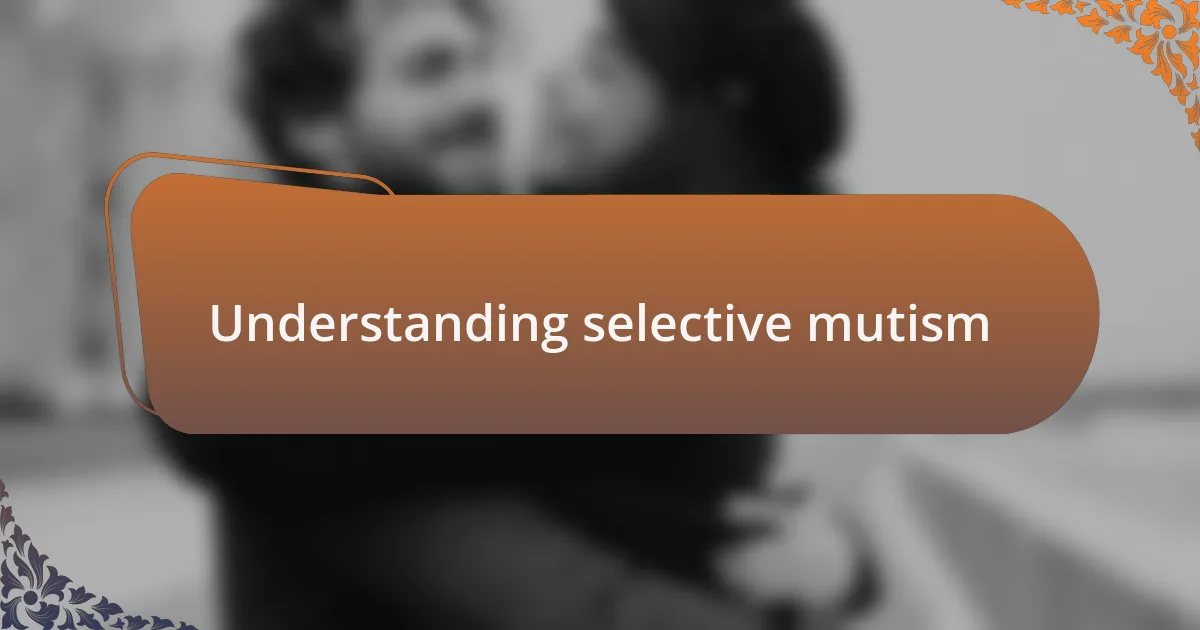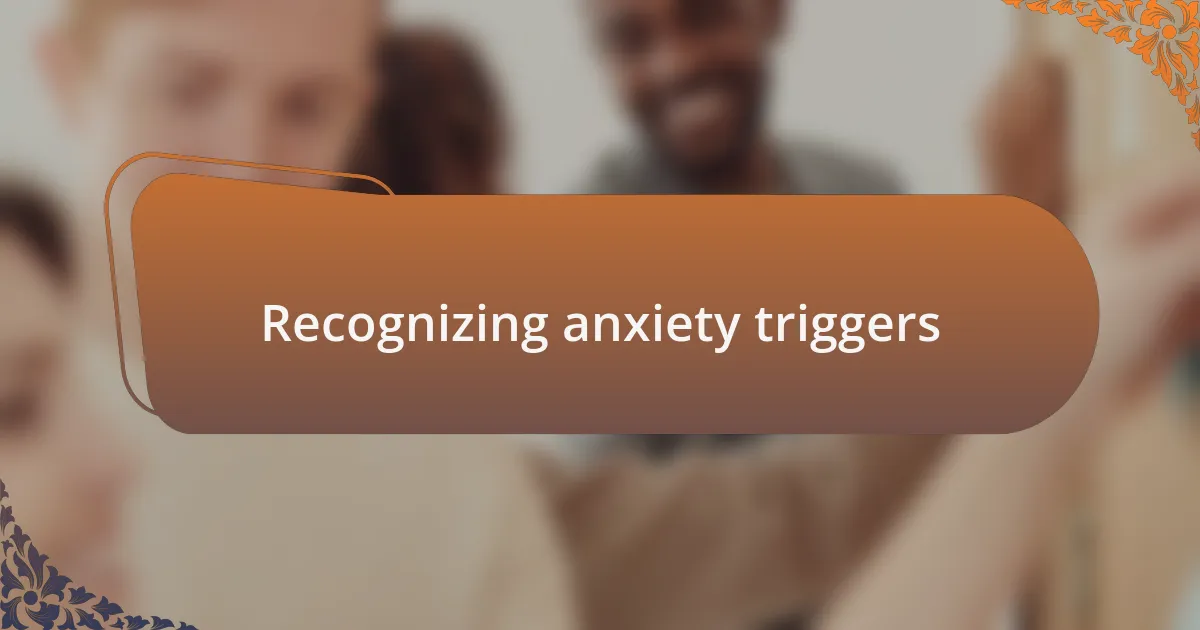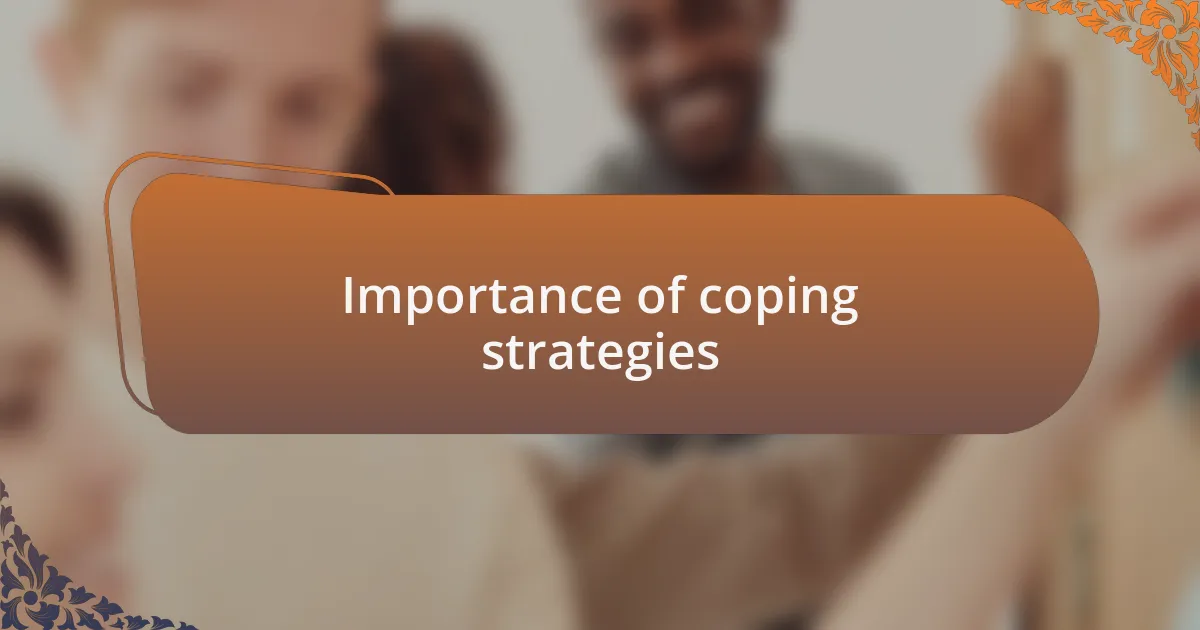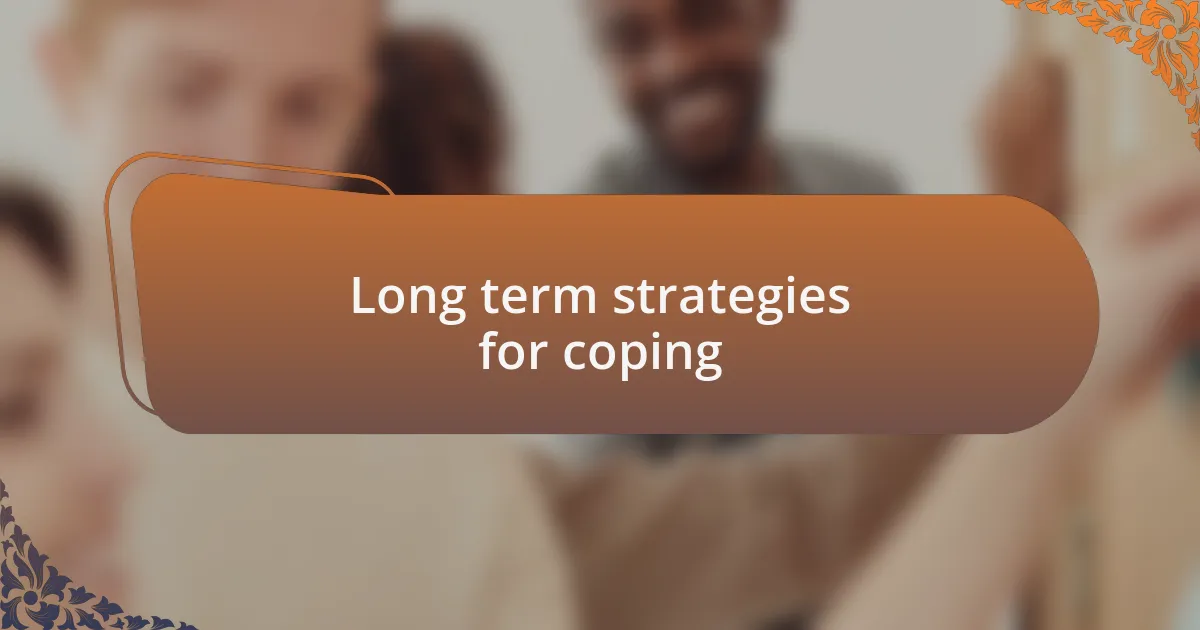Key takeaways:
- Selective mutism is driven by anxiety, often arising in childhood and persisting into adulthood, creating barriers to communication in social settings.
- Identifying personal anxiety triggers is crucial for managing selective mutism and developing effective coping strategies.
- Utilizing coping techniques such as deep breathing, physical activity, and supportive conversations can significantly alleviate anxiety during stressful situations.
- Building a supportive network and practicing mindfulness can enhance long-term coping skills and resilience against anxiety triggers.

Understanding selective mutism
Selective mutism is more than just a challenge with speaking; it’s deeply rooted in anxiety. I remember a time when the sound of my own voice felt foreign in certain environments, like trying to swim in a pool that seemed too deep. Why does speaking become so daunting in those moments? The fear of judgment or misunderstanding can choke our voices, leading us to retreat into silence even when we have so much to share.
At its core, selective mutism often arises during childhood, but it can linger into adulthood. It creates this invisible barrier; I recall feeling the weight of unspoken words in social settings. Do others feel this too? It’s not just me who has been paralyzed by the thought of simply saying “hello.” This emotional experience reflects a profound struggle that many face, often amplified by the expectations of those around us.
When we delve into the triggers that exacerbate selective mutism, we find that they can vary widely from person to person. I often found that one-on-one interactions felt safer, while larger groups left me feeling exposed. Have you noticed how the environment influences our ability to communicate? Understanding these triggers is essential, as they shape our experiences and inform ways to cope and navigate through our silence.

Recognizing anxiety triggers
Recognizing anxiety triggers is a crucial step in managing selective mutism. For me, certain places, like crowded cafes or bustling classrooms, amplify my anxiety. It’s almost like a spotlight shines on me, making the act of speaking feel impossibly heavy. Have you noticed that specific situations make your heart race or your throat tighten?
One of the most revealing moments for me was during a family gathering. While laughter and chatter swirled around, I felt completely paralyzed by the fear of saying something wrong. I could sense the weight of expectations in the air, which only heightened my anxiety. Why does that happen? Often, it’s the thought of being judged or misunderstood that turns small talk into a monumental task.
Every individual’s triggers can be incredibly personal and nuanced. For instance, just a simple question like “How have you been?” can plunge me into a spiral of self-doubt. What if I don’t perform well in that moment? Identifying these specific instances can be liberating; it helps to map out what situations warrant caution and what strategies I can employ to face them. Have you taken the time to reflect on your own experiences with communication? Recognizing these triggers is the first step toward finding effective coping mechanisms.

Importance of coping strategies
Coping strategies are essential tools in navigating the intense emotions tied to anxiety triggers. I remember a particularly overwhelming day when a sudden question in a group setting left me frozen, my mind racing. In that moment, grounding techniques, like focusing on my breath, were not just helpful—they were necessary. How often have you wished for a lifeline during those panic-inducing moments?
When I actively employ coping strategies, I experience a profound shift in my confidence. For instance, during public speaking exercises, I practiced visualization techniques. I imagined a gentle, supportive audience rather than one that scrutinized my every word. This mental shift transformed my anxiety into a sense of empowerment. Have you tried reframing your thoughts in similar situations? It can truly be a revelation.
Ultimately, coping strategies serve as a bridge, connecting us from a state of anxiety to one of manageability. Some days, my go-to method is simply writing down my thoughts. Putting pen to paper helps untangle the web of worries in my mind, creating clarity. Recognizing that I have this toolkit at my disposal alleviates some pressure. Isn’t it amazing how a few small strategies can open up possibilities?

Techniques for managing anxiety
Finding comfort in familiar routines has been a game changer for me. On particularly tense days, I engage in physical activities, like going for a brisk walk or practicing yoga. I’ve found that the rhythm of movement helps channel my anxious energy into something positive. Have you ever noticed how simply changing your environment can alter your mindset?
I also lean on deep breathing exercises during moments when anxiety threatens to take over. A few slow, intentional breaths can ground me, creating a bubble of calm amidst the chaos. I recall sitting in a waiting room, feeling the swirl of anxiety; focusing on my breath not only eased my tension but also gave me a moment of clarity. Have you tried using your breath as a tool? It might surprise you how effective this simple practice can be.
Additionally, I make it a point to connect with supportive friends or family members when anxiety surfaces. Reaching out for a chat has shown me that sharing my feelings lightens my mental load. I vividly remember a time when I called a friend before an important meeting, and their words of encouragement made all the difference in calming my nerves. Isn’t it fascinating how a little support can create such a powerful shift?

Personal experiences with triggers
When I encounter particular triggers, my body often reacts before my mind can process what’s happening. For instance, I remember standing in line at a coffee shop when the noise level suddenly spiked. My heart raced, and I felt a tightness in my chest as the chatter and clinking of cups overwhelmed me. In that moment, I realized how quickly my anxiety could be ignited by something seemingly mundane. Have you had a similar experience where everyday situations turned into sources of stress?
Another moment that stands out to me was during a family gathering. Surrounded by relatives, I felt an urgent need to retreat when conversations became too loud or chaotic. I eventually found a quiet nook to collect my thoughts. It was a profound reminder that it’s okay to prioritize my comfort, even in social settings. How do you navigate situations where the atmosphere feels overwhelming?
Sometimes, triggers come unexpectedly, and I’ve learned to anticipate that response. One day, while attending a workshop, the speaker’s rapid-fire delivery unexpectedly set off my anxiety. Instead of freezing, I excused myself briefly to take a walk outside. The fresh air did wonders, allowing me to return with a clearer mind. Isn’t it empowering to find those small ways to regain control?

Building a support network
Building a support network involves surrounding yourself with understanding and compassionate individuals who can help you navigate your experiences. Once, a close friend reached out to me after I shared my struggles with anxiety during social events. Just knowing I had someone to talk to made those overwhelming moments feel less isolating. Have you found a friend who truly gets what you’re going through?
Over time, I discovered the importance of connecting with others who experience similar challenges. Joining a support group was a turning point for me; hearing others share their stories made me feel validated and less alone. It was a comforting reminder that I’m not the only one facing these triggers. Isn’t it liberating to share your burden with those who can relate?
I’ve also learned to leverage my family as a key support system. When I feel anxious before big family gatherings, I tell them in advance about my feelings. Their understanding makes it easier to express myself when the atmosphere becomes overwhelming. Have you considered how your loved ones can play an active role in your journey?

Long term strategies for coping
Navigating anxiety triggers over the long term requires intentional practice and self-awareness. I found that incorporating mindfulness techniques into my daily routine was transformative. Breathing exercises and meditation not only help ground me in the present but also empower me to manage anxiety when it surfaces. Have you ever tried pausing to focus solely on your breath during a stressful moment?
Another strategy that has proven effective involves setting small, achievable goals. For instance, I gradually challenged myself to engage in conversations in low-pressure settings, like chatting with a cashier. Each successful interaction built my confidence, proving to me that small steps can lead to significant progress. Isn’t it fascinating how every little achievement can serve as a stepping stone toward greater resilience?
Additionally, maintaining a journal has been a powerful tool in my coping strategy. Writing down my thoughts helps me process my emotions and recognize patterns in my anxiety triggers. It’s almost cathartic to see my feelings laid out on paper; I can reflect on them later, which helps demystify what I experience. Have you considered journaling as a way to gain clarity on your own feelings?